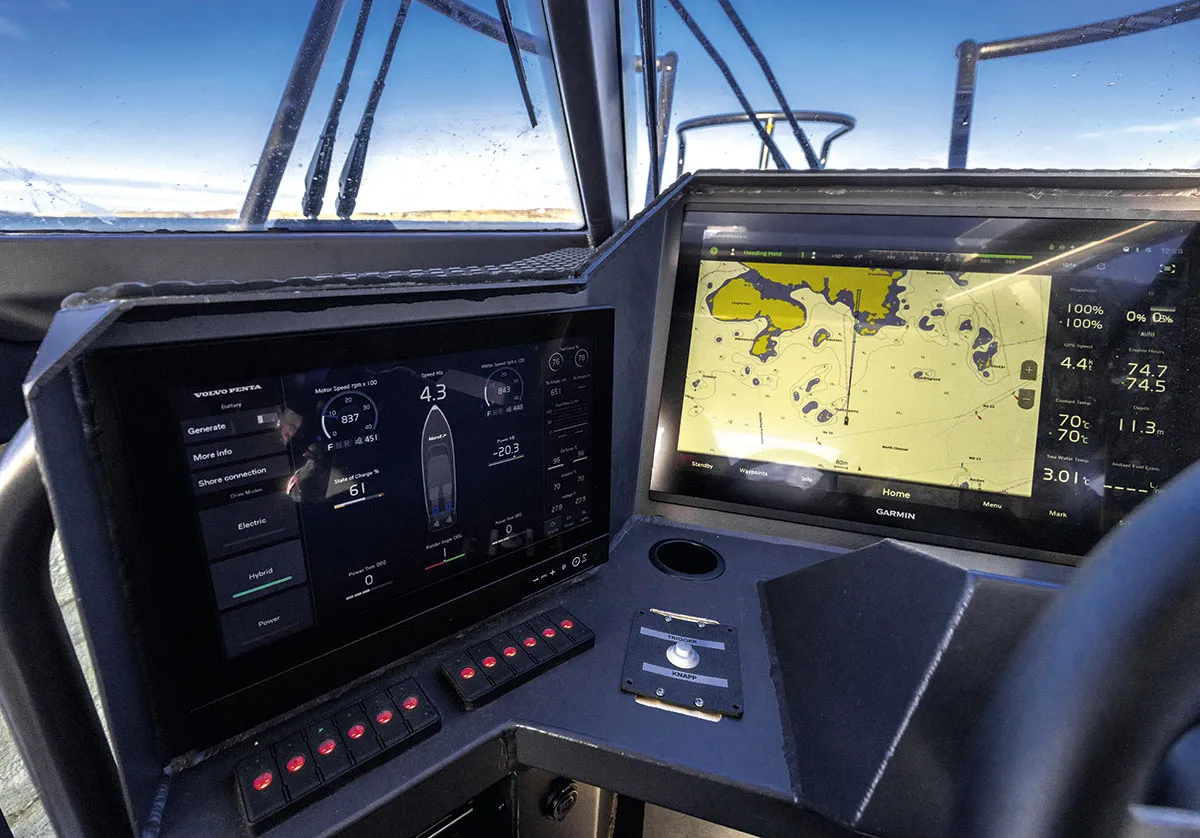At the top of the world a quiet revolution is taking place. In Svalbard, a Norwegian archipelago a little over 1,000km away from the North Pole, a marine engineering company, a boat builder and a tour operator are piloting a scheme that they hope will convince the world – or at least a few more customers – that commercial boats don’t need to be powered by smelly, sputtering diesels. Instead, they could use something altogether more modern: a hybrid-electric drivetrain.
The scheme works as follows: marine engineering company Volvo Penta has built a state-of-the-art, hybrid-electric drivetrain that’s fitted to a boat built by Marell. This package is then sold to a tour operator called Hurtigruten, who run Norway’s ferries and boat tours in Svalbard. Here’s where it gets interesting. Hurtigruten won’t be buying the boat, they’ll pay for it by the hour.
The aim here is to tempt a marine industry that’s sceptical, risk-averse and wary of sinking costs into new tech to test the waters. ‘You pay by the hour. We worry about the future’, is the pitch in not so many words. Volvo Penta still owns and services the boat’s machinery; Hurtigruten just operates it.
Why test it in the wild, frozen North? Well, whether it was intended or not, the Volvo Penta system makes a lot of sense out here. The Arctic’s soundtrack is one of silence. There’s almost nothing here to make a noise. To disturb the peace with the chugging of a diesel motor, while trying to sneak up on a polar bear, one of the planet’s fiercest predators, seems counter-productive at best.
And just as importantly, a boat that makes little noise and has less environmental impact as you explore the archipelago’s jaw-dropping beauty will appeal to eco-savvy customers. Plus, if it works here, where the icicles are as tall as people, it should work everywhere else in the world.
Svalbard also makes a lot of sense as an early adopter, since it’s under serious threat from climate change. The archipelago is one of the most climatically sensitive areas on Earth. Average temperatures have risen here by 1.7°C in the last decade, twice the Arctic average and seven times the global average.

More than anything else, these changes will affect the polar bears who stalk the sea ice for seals that come up to rest. As the sea ice recedes, so will the bears. So the people that live here have to deal with a conflict, one that’s playing out across the planet: when your livelihood depends on tourism, can you keep earning a living in a way that’s sustainable for your, and the planet’s, future?
One boat isn’t going to answer a question as huge as that, but as I was lucky enough to be invited to see this pioneering boat, I can, at the very least, share my thoughts. There’s an obvious parallel in the car industry that’s almost a cliché to bring up, but, that said, I hope this could be a ‘Tesla’ moment for tour boats. The Kvitbjørn (Norwegian for polar bear) is a brilliant innovation that, to this passenger, made a compelling argument.
First off, let’s acknowledge a couple of things. Kvitbjørn is still a hybrid; there is still a diesel engine for crossing the large expanses of water between peninsulas. In a place where being marooned means risking becoming stuck in sea ice, I can understand why a captain might want to hold on to their engines. The boat also isn’t totally silent. Standing on the deck you can hear the whir of the motor and gears as they power small thrusters below, but honestly, I’ve used louder kitchen equipment.
Out on the sea ice, where the water starts to clump together in crystals and the glaciers glow blue as they meet the coast, the quiet feels like a blanket. The Kvitbjørn feels sympathetic to this, doing its best to give way to the occasion. There’s no noxious diesel fumes or noisy engine to ruin the moment.
In fact, you don’t even need to drop anchor – there’s a virtual one. ‘Drop’ it and the electric thrusters keep the vessel in place, pulsing to stop it running away with the currents. Volvo Penta doesn’t know if the boat is quieter below the water yet – and therefore kinder to the sealife than a traditional motor – but is hoping to test it and see how it fares over a reef.

If this does tempt you to sell all your property in order to start operating your own tour boat, then luckily you’d probably be able to drive Kvitbjørn too. I did. There’s a traditional wheel, next to a much more clever joystick that lets you rotate the boat on the spot and move side to side without having to turn. It’s just like a video game.
So, is this small scheme enough to change the world? Who can say, but Volvo Penta and Hurtigruten believe that there’s a huge number of trips – and not just for tourists – that could be powered completely by electricity, and this is a step towards that future.
This pilot isn’t a one-off. Volvo Penta’s ambition is to scale this system across all its machinery and provide buyers with an electric option. And what about that diesel? Well, Volvo Penta is optimistic that greener fuels (not from fossils) will help mariners transition as battery ranges extend further.
Either way, I’m probably not going to look at a trip on a boat the same way again.
Read more about the future of transport:
